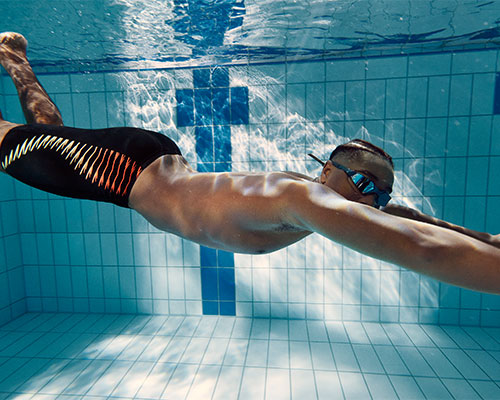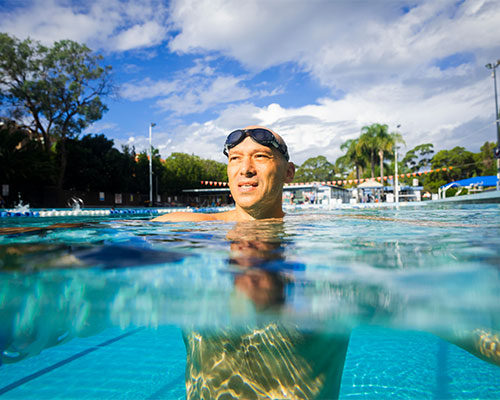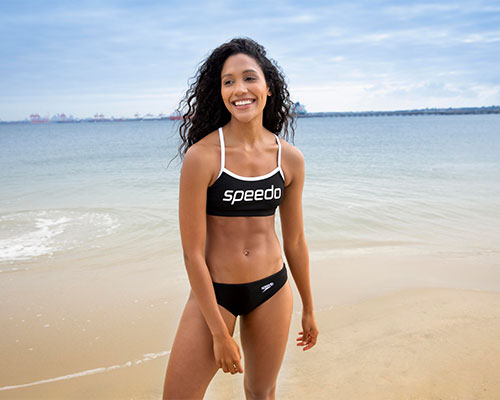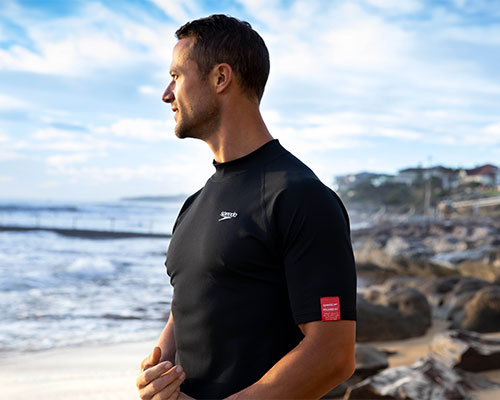Open water swimming is one of those sports that screams excitement and exhilaration. From the thrill of the great outdoors to the unexpected changes in water temperature and day-to-day weather, open water swimming is a next-level sport and is super demanding on your fitness and endurance. But, it's not just for the pros-as long as you are confident in your swimming skills and endurance, anyone can do this.
If you're a swimmer who is wanting to get into open water swimming, there are some things you need to know before taking the plunge-whether that's the ocean, lake, or another body of water, knowing how and where to start is crucial for a good open water swim.
How to Train for Open Water Swimming

When it comes to open water swim training, it may not be as simple as you might think. If you're already a strong swimmer, it will be easier to get your body used to the endurance and technique needed for open water swimming. If you're a complete beginner, it will just take some time and practice to prepare your body for the open water.
Pool vs Ocean Swimming

Obviously, a controlled environment, like a pool, is very different compared to the unpredictability of the open environment, whether that's choppy seas or a calm lake. Your fitness and endurance will be tested for the whole time that you're swimming openly.
Before hitting the waves, build your swimming stamina in the pool first. If you can't swim for very long in the pool, the conditions of the ocean will be even more taxing on your body. Building up your fitness and stamina in the pool first will ensure that you will have enough energy and endurance to tackle the waves head-on.
Some other ways to improve your endurance and fitness are:
Breathing Techniques: Breathing is a huge part of good swimming technique and is used to improve your overall cardiovascular endurance. In a pool, many swimmers will favour one side for breathing, and is a common technique while in the pool. The controlled environment means that the water is stable, and you can generally swim comfortably while breathing to one side.
Unfortunately, breathing to one side while open water swimming is not ideal, as it is easier to ingest more water, thanks to the unpredictability of the waves, wind, and swell on the day. While training in a pool, learn how to breathe on both sides comfortably, train to go without breathing for a few strokes, and switch sides regularly. This will help you improve your breathing rates to accommodate for unpredictable water.
Arm Stroke Technique: In the pool, where the conditions are fairly even, swimmers can get into a comfortable rhythm with their arm strokes and won't have to change much during a swim. This is not the case for open water swimming.
Depending on the water conditions, you will need to alter your stroke technique, especially if the water is super choppy or the swell is pushing you from behind. Practice alternating deep arm pulls and shallow strokes to mimic the different conditions you'll face in the open water. This will make sure you're ready to tackle any condition.
Open Water Swimming Techniques

Once you've improved your open water swimming technique by practising your breathing and stroke in the pool, you'll be ready to take on the open water. It may be tempting to dive straight in and swim in deeper water, but you should start your swims in shallow water - deep enough to swim but shallow enough that if you need to take a break, your feet can touch the bottom. This will help you get used to the conditions before taking the next step to seriously deep water.
What to Wear When Open Water Swimming
Depending upon the season and where you'll be swimming, will determine what open water swimming gear you'll need:
- Swimming wetsuits: Swimming wetsuits are crucial for keeping you warm and protected in colder water temperatures. They also help you stay buoyant, which will make it a little easier when swimming long distances, as well as crucial protection from the sun.
- Swimming cap: Swimming caps are an essential item for open water swimming. Depending on the water temperature, you can either opt for a standard latex cap for warmer waters or a neoprene swim cap for cooler temperatures, and can also help you stay a bit more streamlined in the water. Choose a bright colour so that you will stand out and be visible to others while swimming.
- Swim Accessories: For open water swimming accessories, there are few to consider. Flippers are a great way to help ease your body into swimming in a new or unfamiliar body of water. They help propel your body through the water, meaning that you can focus on your breathing and sighting technique without having to feel worn out from kicking.
Another accessory that can definitely help your swim is a good pair of goggles, designed for murky or limited vision in the water. Most places that you will open water swim will not have clear water like a pool. A pair of open water goggles will help you see more clearly in the water and allow you to sight buoys and other swimmers more easily. You can also try an anti-fog spray to ensure that your goggles will stay clear no matter how long you swim.
Learning How to Sight in the Open Water
When training in the pool, it is easy to swim in a straight direction, as the lines on the bottom of the pool act as convenient guidelines. When you start to open swim, you will have to swim without any guidelines, which can make it difficult to swim in a straight direction.
Instead, it is recommended that you use a technique called sighting to mark your distance. Instead of using pool lines, when you take a breath, look for a distinct landmark - a distinct tree, a parked car, etc. can be used to mark how far you've swum and will ensure that you're swimming in the right direction.
While training in the pool, try and practice sighting. As you stroke, turn your head to the side like you would to breathe and rotate your head forward, slightly lifting your goggles out of the water to look ahead. This may take some practice, as the motion can make your lower body drop, which will require you to kick harder.
Open Water Swimming Safety
When it comes to staying safe while open water swimming, there are a few ways to make sure that you're being as safe as possible. Along with a brightly coloured cap, swimming with a buoy is a great way to make sure that you're visible in the water. Open water swimming buoys come in super bright colours, are light enough to be towed behind you, and will ensure that other people nearby, boats, and lifeguards can keep you in sight.
Some other ways to stay safe during your open water swim is:
1. If the weather is particularly volatile or the water is choppy due to high winds, do not attempt to open water swim unless you have built up your strength and stamina.
2. If swimming in the ocean, make sure to check local shark trackers or sightings before attempting a lengthy swim.
3. The glare of the sun on the water can cause sunburn and sun damage if not careful or properly protected. Make sure to wear enough sunscreen and reapply regularly.
Benefits of Open Water Swimming.

Along with increasing fitness, endurance, and stamina, immersing the body in cold water for prolonged periods has been shown over the years to have significant benefits on your physical health and wellbeing. These include:
- Improved muscle recovery
- Reduction in pain and inflammation
- Boosts immune system
- Improves circulation
- Releases endorphins
- Increased alertness and energy levels
Open water swimming is definitely a sport that will take some time and effort to master, however, with practice and perseverance, you'll be open water swimming in no time.
Check out the range of swimming gear and accessories from rebel.